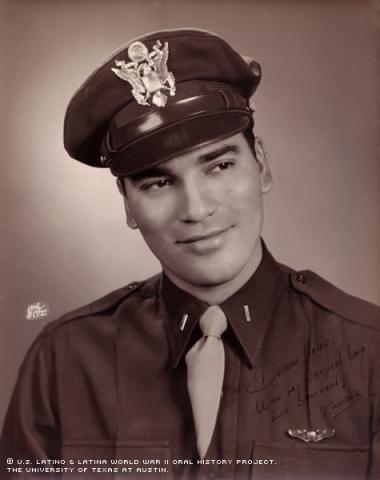
By Julie Flowers
Richard Ortiz was a senior at San Antonio Technical Vocational School in 1941 when he heard a fellow classmate discussing plans to go to college. At that moment, Ortiz realized that pursuing a higher education was an option for him, too.
“Man, if you can go to college, I can go to college,” Ortiz recalled saying to himself.
With aspirations of becoming a pharmacist, he knew he needed more education. He also knew he didn’t have the money for tuition.
Fortunately for him, the GI Bill was created in 1944. By joining the military, he could attend school for free afterward.
“I got out of high school in June of ’41 and I had already enlisted,” Ortiz said.
He signed up for three years in the Army Air Corps with his friend Henry Mesa. Ortiz and Mesa completed their basic training at the Jefferson Barrack, near St. Louis, MO., during the summer of 1941. From there, they were taught airplane mechanics at Chanute Field in Illinois. After completion of this specialized training, the military sent Ortiz to Presque Isle, Maine; Mesa was shipped to San Diego, Calif. In Maine, Ortiz was assigned guard duty from February to March of 1942.
During this time, the US joined the war effort after an attack on Pearl Harbor in December of 1941. Ortiz was sent to Washington D.C., and from there would spend the next two years in Khartoum, the capital of Sudan, and Al Fasher, in Sudan’s North Darfur region. He was a part of the North African Campaign Air Transport Command, which helped maintain and refuel the aircraft being flown across Africa.
There were only about 45 men stationed at the military base in Khartoum, said Ortiz, who added he was told he was the first Texan assigned to the region during the war.
“We were taking over the Pan-American line that was going through Africa,” said Ortiz, referring to one of multiple lines of Pan American World Airways, which flew under U.S. military contract during WWII.
Ortiz has many fond memories of testing the planes he fixed. Pilots would fly in and out of the base to get their equipment checked. They were Ortiz’s only true source of wartime information, as his station was isolated and didn’t receive news from the field.
Ortiz emphasized his great experiences of traveling in that part of the world, attributing all of those opportunities to having enlisted in the military. On leave, he visited Alexandria, Cairo and Jerusalem, “the Holy Land,” speaking proudly of his memories and photographs from those trips.
Ortiz’s WWII days opened his eyes to the world and opportunities ahead of him. In the military, he never encountered racism or segregation, as he had in his upbringing in San Antonio, and this experience motivated him to want more for himself and his family.
In May of 1944, Ortiz returned to the United States. He was stationed in Michigan and, because he was accustomed to flying, was assigned to the ATC Air Transport Co. Medical Evacuation Squad, air crews that delivered wounded GIs to hospitals close to their homes. Ortiz took pride and joy in bringing these veterans to their families.
When the victory in Europe was announced, he went into Detroit for the night.
“[The celebration] went all night,” he remembered, chuckling.
Even though the U.S. had won in Europe, there was still plenty for the servicemen to do. Ortiz continued working with the medical evacuation mission, and enjoying viewing America from the sky, acquiring 300 hours of flying time within an approximate 18-month period.
In October of 1945, he was honorably discharged from the Army as a Staff Sergeant and returned home to San Antonio. With the support of the GI Bill, he graduated in 1951 from the University of Texas at Austin’s College of Pharmacy. He worked for a time as a staff pharmacist for the Veterans Administration, as well as had his own pharmacy.
As a member of the Army Reserve and, later, the Texas Air National Guard, Ortiz remained involved with the military throughout the years. In 1952, he married Elena Villarreal. They made their home in San Antonio and had five children: Richard Rene, Patricia, Daniel Philip, Pamela J. and Carlo Jaime. Four of the five children have had at least two years of college.
When asked about the proud moments of his life, Ortiz said: “I was the first one to graduate college from my family.
“It’s been a life where we didn’t lack anything. I could support my family and could give them what I didn’t have,” thanks to participating in the Armed Forces, he said.
His own parents, Maurilio Reyes Ortiz and Josefina Duron Aguirre Ortiz, natives of Mexico, worked hard to support their four children on Maurilio’s earnings as a laborer. Ortiz said that growing up, he noticed segregation between Anglos and Latinos. For one thing, the white and Latino children were separated in four of his classes.
Had his Anglo classmate not stated his plans to attend college, Ortiz said he wouldn’t have even entertained the possibility of attaining a college degree.
“If he hadn’t gone up there and said it, I probably wouldn’t have done it,” Ortiz said.
He ended up learning just as much, if not more, about life from his WWII experience, however.
“It showed me that you can do anything you set your mind to,” Ortiz said.
Richard Ortiz was interviewed at the San Antonio Veterans Center in San Antonio, Texas, on November 6, 2004, by Antonio Gil.

